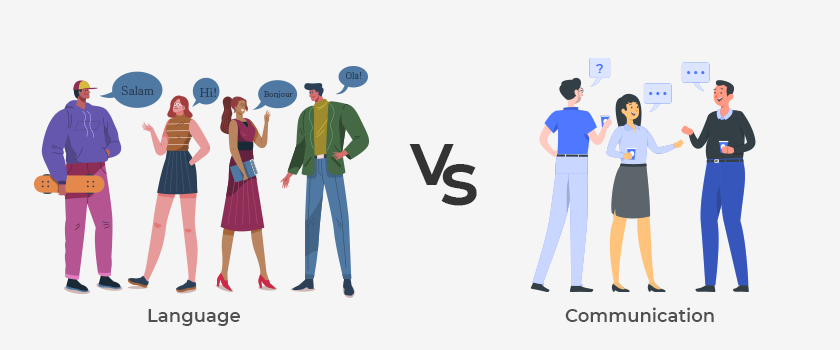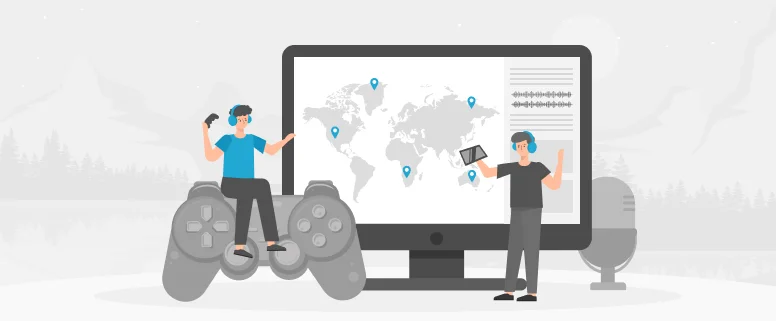Language, as we all know, is the way to communicate and interact with each other. Whereas communication talks about the exchange of information and ideas. Language is inevitable to communicate and interact. A lot of people use the terms language and communication interchangeably. However, there are certain differences between them that are important to understand.
First, let’s talk about these terminologies separately.
Table of Content
Communication
Communication is basically described as the methodology of exchanging messages or data, between two or more people.
Language
Language is described as a system of communication that is utilized by a specific group of people living in a community.
Differences Vis-A-Vis Properties
- Language is a tool that we use for communication. Whereas, communication is a process
- Language focuses on signs, words, and symbols. On the contrary, communication pertains to the message that is being conveyed.
- Language occurs primarily in auditory channels, i.e., we generally make use of language by talking. But if we talk about communication, it uses all sensory channels.
- Language is always dynamic, whereas communication is static.
Language Vs Communication
A language is a form of expression that allows human beings, who are living in a community, to interact with each other. Many define language as a structure of written symbols that carry specific meanings to every word.
Others may say that language is a form of communication, which is rudimentary and a correct statement. However, if you study its characteristics, language is a bit more complicated.
Characteristics of Language
1. Elucidating Language
Over time, linguists have used many definitions to explain the concept of language. For instance, one of the most renowned English scholars, Henry Sweet, claimed that if you amalgamate speech and sound into one entity, it can allow you to express your inner thoughts. These thoughts reach the listener in the form of a language.
Utilization of words, and then constructing these phrases in such a structure that it makes sense to the observer. However, one important thing to note here is that language occurs primarily in auditory channels. It has to be vocal. Communication can be non-vocal as well, but the language has to be vocal. This is the big difference between language and communication.
2. The Initial Phase of Understanding Language
If you want to understand the concept of language, try to pay attention to a child’s way of communicating. Every person that grows up, acquires the fundamental part of language and communication during his toddler years. It usually pertains to the sounds he makes while conveying his needs. The gestures he develops over time due to constant stimulus are part of this process.
How and when to use them in order to get what he wants is the key to communicating with a child. These constant stimuli get embedded in his subconscious and then consciousness. Eventually, with time, he develops a sense of the language he will have to ameliorate.
3. Linguistic Knowledge
Linguistics is a broad subject and a whole domain of language. Once a person starts to improve his language skills, the hand gestures and sounds that he once learned as a kid, transform into proper words and phrases. He starts to speak the language in a proper way. Now, he has the option to choose different words for different situations.
He can change the tone of his words, and simply change the meaning of the sentence. These characteristics showcase that a person has attained the knowledge pertaining to that language.
4. Sound System
Once a person learns a language, he indulges in the nitty-gritty of the language. He fully understands the signs and gestures and their use according to the situation. Another important aspect is the sound system of the language. There is a prevalent concept of the combination of the sounds of the language;
- This majorly includes what sounds are supposed to be made, once a word is started.
- The next stage is about sound and utilizing it to end the particular word.
- Eventually, there are certain words where the sound used is somewhat similar. Hence, the speaker of that language has to be aware of those sounds. And, should be able to distinguish between them.
5. McGurk Effect
Many people don’t know one important aspect of the diameter of the sound system in languages, i.e. the tenet of facial expression. If you make a sound of a particular word, your lips move accordingly. But there are certain words, where lipsync tells a completely different story. This is known as the McGurk effect.
If we further illustrate the McGurk effect it shows that if you make sounds of the words that go as, “ ba ba”, your lips will proclaim the words “ ga ga”. However, the Mcgurk effect will probably hear something like, “ da da”.
The Creativity of Linguistic Knowledge
Language is not bound by a certain number of sentences. You can create hundreds of sentences every day and still will never run out of the possibility to create new ones. However, if you have a firm grip over a language it will allow you to establish sentences that have never been used before, bordering a major difference between language and communication.
People often hear new sentences every single day that they never heard before. But they are able to understand and comprehend the message behind those words. The reason states that your brain has the creative ability to make sense of new words.
1. Encoding Messages
Since you are aware of all the linguistic preferences, nuances, and intricacies, your brain automatically interprets the newly constructed sentence with the old ideas that have been long stored in your brain.
Hence, the reason you cannot recall the complete sentences a person has told you but can immediately recall the general idea of that message vis-a-vis your own word bank. This is the creative aspect of linguistic knowledge.
Communication
1. Elucidating Communication
When you transfer information or any sort of data from one person to another, this process is called communication. The important aspect of this process is that there have to be three elements for the process of communication to be completed;
- One sender
- A message
- The recipient
Process of Communication
1. Encoding Messages
The first step in the process of communication is when the message gets encoded by the sender or the speaker who initiates the conversation.
So, the sender takes the words and composes them in a structured way to make sense. Once this structure is completed, he uses aids vis-a-vis nonverbal communication and encodes the message.
2. Transmission of the Message
After the step of encoding, the message is transmitted via a medium. This medium could take multiple forms. For instance, it could be in written form or in speech form. The possibility that there can be multiple recipients is also prevalent. If the message itself is complicated, different recipients can interpret and understand the same message in different ways.
3. The Recipient Dilemma
The fact that you cannot control how the other person( recipient) perceives the message, makes the process of communication even more dynamic. There is no universal way of communicating. The fact that perceptions are influenced by the cultural intricacies of the surroundings, and the personality traits of the individual, puts the sender in quite a dilemma. Because there is always a chance that the original message of the sender never gets understood exactly in the way he intended to convey.
4. Multipolarity of Sender And Receiver
One important aspect of the process of communication that needs to be discussed here is that face-to-face communication does not adhere to one particular sender and one recipient. As the conversation initiates and progresses, the roles of the sender and the recipient bounce back and forth between the participants. Words and language are just the mediums that carry the intentions held by the sender hence making the language vs communication battle even more complex.
Whereas, the library of nonverbal communication compels the participants to understand the intended meanings behind those messages. The slight use of touch, the intensity of expression, the forceful nature of vocal power, eye contact, posture, and sudden body twitches allow the communication process to enhance.
Factors Affecting The Process of Communication
There are many influential factors that affect the process of communication. It’s just not a simple transfer of a message from one person to another. Let’s list some of them:
- Cultural environment
- Traditional context
- Emotional state
- Perception of the receiver, as well as the speaker
- Situational context
- The location where the conversation takes place
1. Categories of Communication
Communication is not limited to one type. There are different ways to communicate. Since the aim is to effectively convey the message, one cannot restrain himself to one particular methodology.
Let’s discuss some of the various categories of communication;
2. Verbal Communication
As the word suggests, verbal communication takes place as a result of a verbal chat or vocal conversation between two or more people. The medium can vary. For instance, you could conduct verbal communication via telephonic conversation, or via a television screen, where a person is talking and you are listening.
However, there are certain constant factors pertaining to verbal communication. They include; sender, medium, and receiver. Without these factors, the process of verbal communication is not complete.
3. Non-Verbal Communication
Non-verbal communication does not involve any spoken conversation. It’s quite surprising to see that you can actually convey an entire message without uttering a single word. This is the power of nonverbal communication.
Nonverbal communication is actually the product of various body language gestures that an individual adapts over time. These gestures and movements are learned by the individual during his upbringing. The cultural intricacies and the linguistic nuances are different for different regions. Some gestures might mean something else in a given social setup. So, it’s all about the agreed and preconceived nonverbal tenets that society has accepted and reapplied over time and again.
4. Written Communication
Written communication is a subsection of non-verbal communication. However, it constitutes the use of language in the written form. The written form has evolved with time. There was a time when people used to write on walls and stones. With the gradual evolution of the human mind, the masses became more sophisticated and moved from hard stones to leaves and leather pieces.
Innovations led to the creation of paper which enabled humans to become more efficient in their writings and storage of documents. Globalization and the age of the internet led to the digital revolution, and humans started to use emails and social media platforms to communicate with each other.
Conclusion
The above write-up addresses the detailed differences between language and communication. It also talks about the rudimentary changes between language and communication. Language consists of phrases and words that are used to describe an emotion or statement. They are not bound by any literature or science. The language may change, but the message remains the same. It implies that you can use different languages to convey the same ideas. On the contrary, communication concentrates on the process. The key elements of the process have to be there.







